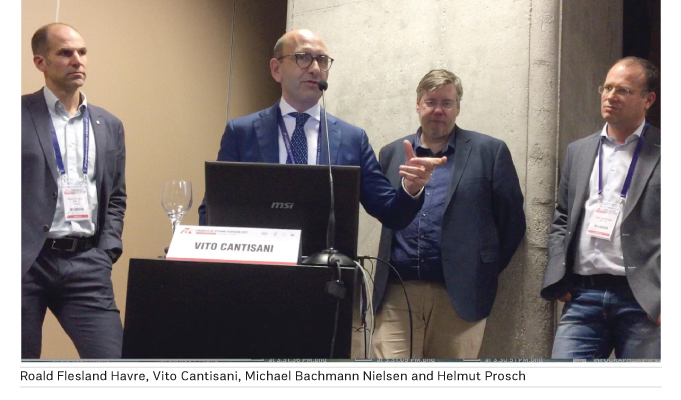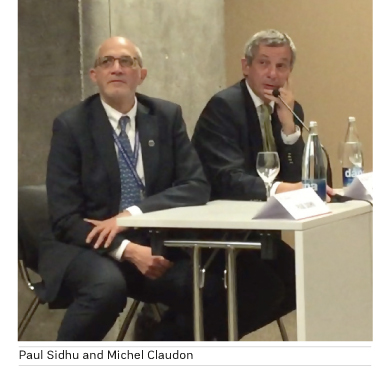HealthManagement, Volume 17 - Issue 5, 2017
One of the main projects of EUROSON School is the introduction of Ultrasound in medical student education as it could be beneficial for many reasons.
In the last year, EFSUMB Education and Professional Standards Committee (EPSC) along with the Publication committee cooperated on several educational and research projects and the organisation of several Euroson schools, mainly on CEUS and US-elastography and endorsed courses,
However, one of the main projects is the introduction of Ultrasound in medical student education. The EFSUMB position on medical student education using ultrasound was presented at Ljubliana, Euroson 2017 Meeting.
Education for students is traditionally based on training methods such as presentations, courses and workshops, the new technologies such as ultrasound equipment and web-based information have educational applications. Ultrasound is recognised worldwide as a powerful tool in the anatomic and pathologic evaluation of different organs, every day even more accessible, thanks to the availability of new ultrasound scanners, which are portable and miniaturised, with lower costs and greater effectiveness. However, throughout Europe, there is differentiation in competency levels (basic, advanced and teacher), which should be defined based on modules throughout Europe.
Reviewing literature, several papers coming from the United States, suggest that US can be effective for educational purposes. Therefore, as reported in a previous newsletter, and in previous ECR and at the present Euroson, EFSUMB decided to focus on student education in order to promote a standardised introduction in the US teaching program at the beginning of student training.
After reviewing the literature and the current experience (Hoppmann et al. 2011; Fodor et al. 2012; Hoppmann et al. 2011; Bahner et al. 2014) and preparing educational material, such as the EFSUMB Course Book for students and website material, EFSUMB published a position paper in two journals, Ultraschall [short version] and Ultrasound International Open [long version] (Cantisani et al. 2016).
Additionally, a new Student Committee was established in 2016 and a Task Force Group prepared a survey which was sent to many European medical school deans. This survey is now available on the EFSUMB website and was sent to all EFSUMB National Societies and mailing list members for completion (https://de.surveymonkey.com/r/897RC8X). Only 56 responses from 14 countries have been received and were evaluated.
From the initial responses we learned that implementing US into the medical school curriculum has been considered beneficial for the following reasons:
- Ultrasound
knowledge is useful for all physicians
- It
is useful to learn for later clinical practice
- It
may help students learn anatomy.
However, emerging barriers for a better standardised US curriculum in medical schools were: Lack of time (in the curriculum); problems in equipment funding and lack of faculty workforce funding. Therefore, the three main challenges are: US EQUIPMENT (need for investment support from US producers?) “each student should have a US machine in the pocket”; SIMULATORS , simple, easy to manipulate, realistic, but expensive and not widely available; TEACHERS specialised in medical education and US practitioners in different clinical specialties currently are insufficient to teach US in an easy way, to explain artifacts and how to avoid them and to explain the limits of the procedure.


More recently first results from experiences in University of Vienna and Gdansk, Bergen, and Oslo have been received. We have collected all Medical School pilot studies results and suggestions and we are preparing proposals for a European ultrasound recommended curriculum platform which will be published in the near future.
In conclusion, currently, US education of medical students is mostly covered by radiology; however, in many medical schools, other departments, (anatomy, internal medicine obstetrics and gynaecology urology, etc.) are probably increasingly sharing the load to achieve this educational goal, but not yet in sufficient student education departments.
More teachers and hands-on training is the goal. Deans, medical education departments, other academics, and students are aware of the need to implement practical US education into the curriculum since they consider ultrasound as a very good educational tool for medical students. Teachers should be qualified experts to help students to identify the relevant data from the large amounts of information in the US image. Medical School pilot studies results will help to promote proposals for a European curriculum platform.
References:
Hoppmann RA et al. (2011) An integrated ultrasound curriculum (iUSC) for medical students: 4-year experience. Crit Ultrasound J; 3:1–12.
Fodor D, Badea R, Poanta L, Dumitrascu DL, Buzoianu AD, Mircea PA. (2012) The use of ultrasonography in learning clinical examination: a pilot study involving third year medical students. Med Ultrasonogr; 14:177–181.
Bahner DP, Goldman E, Way D, Royall NA, Liu YT. (2014) The state of ultrasound education in U.S. medical schools: results of a national survey. Acad Med; 89:1681–1686
Cantisani V, Dietrich CF, Badea R, Dudea S, Prosch H, Cerezo E, Nuernberg D, Serra AL, Sidhu PS, Radzina M, Piscaglia F, Bachmann Nielsen M, Ewertsen C, Saftoiu A, Calliada F, Gilja OH. (2016) EFSUMB statement on medical student education in ultrasound [short version]. Ultrasound Int Open. Mar;2(1):E2-7
Cantisani V, Dietrich CF, Badea R, Dudea S, Prosch H, Cerezo E, Nuernberg D, Serra AL, Sidhu PS, Radzina M, Piscaglia F, Bachmann Nielsen M, Calliada F, Gilja OH. (2016) EFSUMB statement on medical student education in ultrasound [long version].Ultraschall Med. Feb;37(1):100-2.




